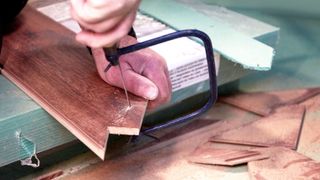What is a coping saw? And why you need it in your DIY toolkit
Discover the answer to what is a coping saw, find out what jobs it’s good for, what it can cut and which blades you need for different DIY projects

If you’re asking yourself what is a coping saw? Then you’ve come to the right place. Here we not only answer what is a coping saw, we tell you why it's called a coping saw, what materials it can cut, how to use a coping saw and reveal the different types of blades you’ll need.
A coping saw is one of many differenttypes of sawa DIYer could/should have in their tool collection. It is a specialist saw for specific tasks, so it might not be an everyday saw, but they are inexpensive and definitely an essential addition for intricate cuts.
What is a coping saw? A quick definition
A coping saw like thisFaithfull Coping Saw from Amazonis a type of bow saw and is commonly used to produce straight, curved and intricate shaped cuts in woodwork. It typically has a U-shaped metal frame, a wooden handle and a narrow blade which is held in place via a couple of pins. The handle is also used to tighten the blade, hold it in place and create the right tension for the job you are working on.
The flexibility in the narrow blade and the shape of the frame allows users to do more than follow straight lines. It can follow curves and create shapes that most other saws can’t or will struggle to do.
Why is it called a coping saw?
The coping saw has been around for centuries and gets its name from a carpentry/woodwork technique known as the cope, which is called coping when in action. The technique is also known as scribing and involves shaping the end of wood so that it fits neatly – and almost seamlessly – into the contours of the wood it is being joined to.
Cope – or coping – is also a technique used in metalworking, which applies the same principles. It is also known as a saddle joint.
What does a coping saw cut?
A coping saw is commonly used in woodworking to cut intricate curved or rounded shapes. A typical example would be wooden flooring where a plank meets a door frame. It can be used to cut out the shapes of the door jamb, the curves of simple architrave or the intricate patterns of more ornate mouldings.
Scribing skirting boardsis another common application. This is where you shape one end of the skirting board so that it fits neatly into a corner against another length of skirting board. This is typically used where mitre joints do not fit together well due to uneven walls.
A coping saw with the right blade – look to use a blade with 24 TPI or similar – can also be used to cut through metals such as aluminium, tin and copper. A blade with a high TPI is also a good choice for cutting plastics such as PVC which plastic plumbing pipe is made of.

我如何使用弓锯?
The first thing you will need to do is install a blade to match whatever material you are cutting. This will differ depending on what coping saw you have, but you typically place one end in the pin and adjust the tension so that when you place the other end of the blade in the other pin it stays in place but isn’t tight.
Then adjust the tension – commonly with the handle – and angle ready to start. Don’t over tighten the blade, while it needs to be secure it also needs to have a little flex in it.
There is an art to using a coping saw and getting curves right. But set the blade at the right angle for the cut, secure what you are cutting and follow the pencil guide you've marked out and all should be good. To get a smooth finish get a sander or sandpaper to remove any rough edges.
If you're cutting from the centre of material or away from the edge you will need to drill a pilot hole first. Then remove one end of the blade place through the hole and then reattach and adjust tension before you start sawing
Are coping saws hard to use?
Coping saws are relatively simple to use, but its shape and blades can make the process seem a little intimidating. The blades typically have teeth which means that you need to pull back a few times to get a starting point. Once you get going it is pretty much a back and forth motion like most saws.
Are there different types of coping saw blades?
Yes. They generally vary by size, TPI (Teeth Per Inch) and finish. A coping saw will have a blade that typically measures between 160-175mm in length. Check your saw to see which size you need.
The most common type of blade is a steel blade with teeth – like theseEclipse Professional Tools Coping Saw Blades from Amazon– that can be used on wood, metal and plastic. The number of teeth determines the type of finish you get. For wood 15-18 TPI is a common option for everyday cuts, but if you need a finer finish you can use a 24 TPI blade.
There are specialist wire blades that have an abrasive surface – rather than teeth – which can be used for intricate cuts on ceramics making them ideal whentiling a kitchen splashback, a bathroom or tiling floors.
Get the Homebuilding & Renovating Newsletter
Bring your dream home to life with expert advice, how-to guides and design inspiration, direct to your inbox.
Steve is Homebuilding & Renovating's DIY content editor, and has been a writer and editor for two decades. He is an avid DIYer with over 20 years of experience in transforming and renovating homes. He specialises in painting and decorating, but has strong all-round building skills, having previously worked in the industry for 10 years.
Bring your dream home to life with expert advice, how-to guides and design inspiration, direct to your inbox.
Thank you for signing up to Homebuilding. You will receive a verification email shortly.
There was a problem. Please refresh the page and try again.

